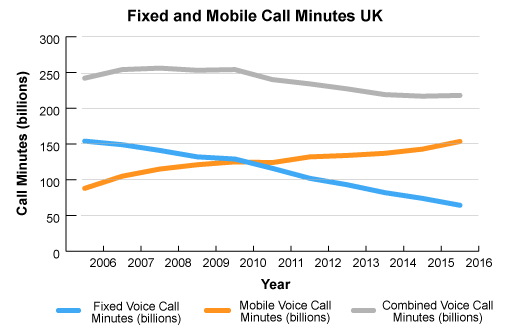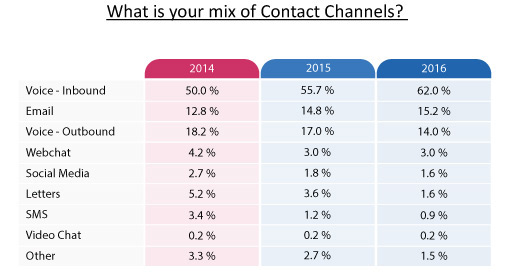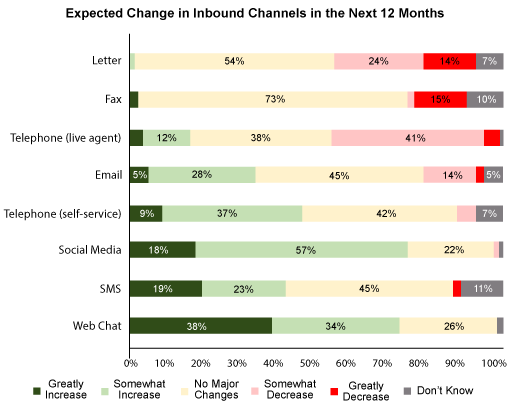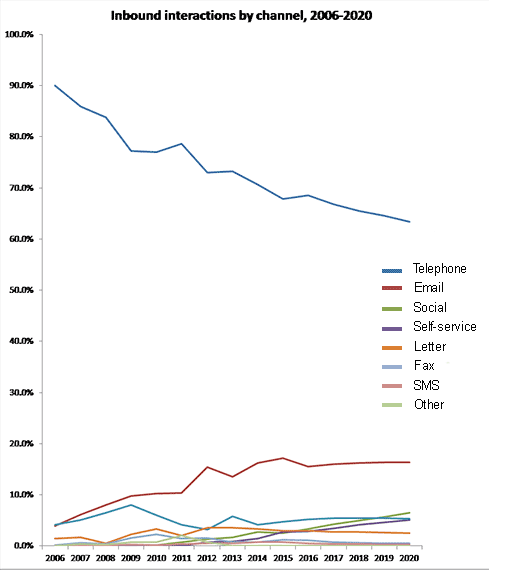Through research we have found that call volumes (particularly for fixed-line calls) are beginning to decline by almost 10% each year.
This is despite the growth in digital channels, which does not seem to have offset the decline in call volumes.
So, is there a danger that contact centres could become a thing of the past? And, if so, how long will it take?
What Do the Facts Tell Us?
Fixed-Line Voice Contacts Have Declined by 8% per Year Over the Past 10 Years
According to official figures from Ofcom, call minutes from fixed landlines have decreased by 58% percent from 2008 to 2016, an average rate of decline of 8% per year. This reflects the wider move from fixed-line contacts, which have traditionally made up the lion’s share of calls in the contact centre, to mobile calls.
However, the regulator for UK communications industries also revealed that voice contacts made from a mobile phone have increased by an average of 5.8% per year.
And even when figures are combined, it still shows a decline in call minutes of 10% over ten years, with an average fall of 1% each year.
| Year | Fixed Voice Call Minutes (Billions) | Mobile Voice Call Minutes (Billions) | Combined Voice Call Minutes (Billions) |
|---|---|---|---|
| 2006 | 154 | 88 | 242 |
| 2007 | 149 | 105 | 254 |
| 2008 | 141 | 115 | 256 |
| 2009 | 132 | 121 | 253 |
| 2010 | 129 | 125 | 254 |
| 2011 | 116 | 124 | 240 |
| 2012 | 102 | 132 | 234 |
| 2013 | 93 | 134 | 227 |
| 2014 | 82 | 137 | 219 |
| 2015 | 74 | 142.8 | 216.8 |
| 2016 | 64.38 | 153.51 | 217.89 |

So the argument that contact centres are in danger of becoming a thing of the past is obsolete, right?
Well, perhaps not, as while the number of voice contacts may have remained steady, our own research suggests that contacts made through other channels fell significantly from 2015 to 2016.
Webchat Volumes Appear to Be Falling
Through our own research, in the paper “What Contact Centres Are Doing Right Now – How do you compare? (2016 Edition)”, we discovered that the percentage of inbound voice contacts had increased from 55.7% in 2015 to 62.0% in 2016.
Such a large percentage jump of overall voice contact centre traffic could indicate that total traffic had actually decreased. Because if the number of voice contacts stayed very similar but its share of contact centre traffic had increased, it could mean that the number of contacts on other channels must have decreased.
In fact, the drop in the percentage of contacts through other channels is highlighted in the table below.

From this table, we can see that the number of contacts made via webchat dropped by over a quarter from 2014 to 2016, social media contacts have been falling year on year and that the growth of video chat has stalled.
This information was based on 340+ contact centre professionals surveyed year on year
Will These Trends Continue?
These trends, which demonstrate the falling number of contacts in the industry, do hint that there is a danger that contact centres may become a thing of the past.
However, research by Steve Morell, Managing Partner at ContactBabel, suggests that these trends may only be temporary.
Steve’s research, which aimed to predict the expected change in inbound channels from 2016–2017, consisted of interviewing senior staff members at over 200 British contact centres.
As part of the research, Steve asked his interviewees for their prediction of the change in traffic volumes from 2016-2017, and the chart below highlights their predictions.

This highlights how contact centres seem to be preparing for a rise in usage of various inbound channels, including webchat and social media, which have been gradually falling in traffic volume over the last couple of years.
This is most likely because, as the generations become more comfortable with digital technology, it is only logical that younger people would prefer to use non-voice channels. So, whilst when these channels first came in, there was a figurative “boom” in usage, customers may have tried using these channels out of interest, but soon they may fall out of favour.
Steve believes that his findings show that “contact centres aren’t becoming obsolete, they’re merely reacting to the changing ways in which customers want to communicate with businesses.

Steve Morrell
“While we can’t see headcount [of advisors] increasing greatly in future, the vast majority of digital interactions (email, social and webchat) are still being handled by humans if self-service isn’t appropriate or effective.
“It’s also noticeable that in the case of complaints (and other complex or high-emotion situations), voice is still the preferred method of communication.”
Below are the results of research conducted by ContactBabel that shows the change in contact volumes as a percentage of total contact volumes, across all channels, in the past ten years. The graph also uses predictions from 2017–2020.

Do the Other Experts Agree?
Steve has had his say, but what about other industry professionals? Do they think that there is a danger of contact centres becoming a thing of the past?
Contact Centres Will Evolve and Not Disappear
I can’t see contact centres becoming a thing of the past. However, just like everything else, they will evolve.
Contact centres are not the same now as they were 10 years ago, and no doubt in another 10 years they won’t be the same as they are now, meaning we will see changes in the way customers use and interact with them as the customer demographic within them changes.
The best contact centres will adapt and grow but they won’t go the way of the dinosaurs, as at the end of the day, we need and crave the ability to talk to others when things go wrong and contact centres fulfil that need.
Thanks to Chris Vale, Contact Centre & Telephony Specialist at CCI
Only When Robots Can Handle Queries Like a Human Being
I really can’t see the call centre dying out until there are Artificially Intelligent (AI) agents that can deal with customer queries as well as a human being can.
If you’re running a heavily scripted call centre then we’re probably not a million miles away from that now (natural language IVRs, for example). But if you are dealing with something of any complexity – that isn’t just “customer provides input, agent provides output based on input” – then you’re going to need people, and therefore contact centres, for a while yet.
Thanks to Phillip Catterall, Senior Forecast Analyst at Experian
Contact Centres Will Improve Access to Customer Information – and Not Die Out!
There is always need for the human touch and I really cannot see the contact/call centre dying out. Instead I see the centres improving their access to customer information. This would be to make the journey as smooth and productive as possible for the customer and business.
Also, I see the customer journey improving and being more secure, allowing customers to do everything without a visit into an office through identification and verification (ID&V) solutions and secure card payment features.
Centres will combine sophisticated IVRs to identify/reduce call time (AHT), help route the call efficiently to allow for first call resolution (FCR), and then place it with the right agent for the job, wherever they are in the world.
Thanks to Joanne Hatherley, Client Services Director
It Won’t Happen Any Time Soon, But May Do Eventually
Not any time soon. But eventually, it’s a distinct possibility. Business itself is changing, with successful new businesses designing their processes from scratch to avoid voice support at all costs.
Customer interactions are all through the web, with the next level provided through email and chat. It’s tough to retrofit that model on a company that relies on a traditional contact centre today, but if you’re starting fresh, it’s the model that makes sense.
As these new companies displace older firms, those agent positions go away. How many positions have been lost as Amazon has taken market share?
Thanks to Jerry Sokol, Principal of Biz Meets Tech
Haven’t We Had This Debate Before?
I first heard in 1995 that voice recognition would end call centres. I then heard something similar in 1998 that the internet would eradicate the need for call centres. Then in about 2001, I heard that UK call centres wouldn’t exist as it was all going offshore.
It’s 2017 and they haven’t gone yet. Self-service is driving away basic transactional call types, but consumer expectations are higher. Expect the volume reduction percentage to drop.
Thanks to Rob O’Malley, Call Centre Outsourcing Consultant
A Contact Centre Predictions Podcast
For more predictions, listen to our conversation with experienced customer service director Keith Gait, in which he shares his thoughts on the future of the contact centre industry.
Below is a recording, while you can find more podcasts by following the link: The Contact Centre Podcast
The Contact Centre Podcast – Episode 19:
Contact Centre Evolution: Where Are We Heading?
For more information on this podcast visit Podcast – Contact Centre Evolution: Where Are We Heading?
Author: Robyn Coppell
Published On: 18th Sep 2017 - Last modified: 24th Feb 2025
Read more about - Expert Insights, Artificial Intelligence, Keith Gait, Omnichannel, Steve Morrell






















I guess it depends on how you define a contact center. If we are talking bricks and mortar real estate then there is no good reason to still have them; the technology landscape now (and has for a while really) allows homeworkers to function as easily as if they were sitting in an office; collaboration tools facilitate inter agent / supervisor communications and pretty much all contact centre solutions allow the interaction (voice, chat, email, social media, etc) to be directed to the most suitable person to deal with it irrespective of physical location.
If we are talking the service the contact centre provides then this will not be disappearing anytime soon, if at all ever; as long as consumers purchase products and services there will always be the need for consumers to interact with someone to assist them in their purchase and aftersales.
The future of the contact centre is definitely about evolution, not disappearance. Take the fact that customer experience is now seen as central to business success – while everyone in a business needs to be customer-focused, it is natural that the contact centre will continue to be responsible for the majority of interactions.